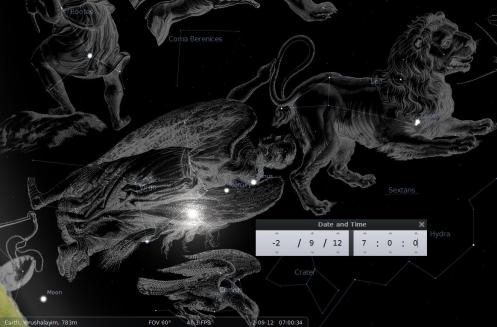The virgin clothed in the Sun
In a previous post we reviewed the work done by Rick Larson around the signs in the heavens around the birth of Jesus: the conjunction of Jupiter (Ha Tzaddiq, the righteous one) with the star Regulus (Ha Malech, The King) in Leo (the lion of Judah) – the sign of Melchizedek (the righteous king) – and the virgin clothed in the sun with the moon beneath her feet (Revelations 12:1-2). Rick pinpoints these events in September 3 BC.
Here we show you the dawn sky from Jerusalem on 12th September 3BC (that’s Astronomical Year -2), with the sky darkened so that the constellations and planets are more visible:
The Gregorian date at which the conjunction of Regulus and Jupiter is most complete is September 13th, -2BC. I’ve shown the 12th because the moon is a bit closer to Virgo on that day.
Dawn was about 4:20am, with the Sun rising in Virgo. The moon rose at 6:40am on the 12th and 7:45am on the 13th. The picture shows the sky at 7am on the 12th, just after moonrise.
The image was drawn in Stellarium, which is a free astronomical software package. The constellations are from the Uranographia of the 17th century astronomer Hevelius. Mark Crossley has made these available as a Stellarium sky culture.



The 17th century Christian mystic and Hermetic philosopher, Sir Thomas Browne of Norwich had an astronomical book by Hevelius in his Library,
‘De nativa Saturni facie ejusque varis Phasibus (1656). Something to do with Saturn, how’s your Latin?
There’s some interesting connections between the fact that if the Persian Magi were of the Zoroastrian religion as established by King Cyrus who is in Isaiah ‘the Lord’s anointed, ‘ shepherd of the Lord’ and the restorer of the Temple, to the birth of Yeshua. Also quite a coincidence in your post title and then having your attention drawn to a hidden 17th c. quaternity of statuettes which includes a Virgin “Mondsichel-Madonna” just 4 days later! Space and Time, the essence of coincidence and the archetypes being activated, perhaps.
E.W. Bullinger quotes Abulfaragius as saying that Daniel was the teacher of Zoroaster. Daniel’s surname is given in the Douay bible as Baltasar (Dan 10:1) – the name of one of the three kings.
Thanks for recommending the E.W. Bullinger, Scalambra, it puts things in perspective. The relationship between Daniel and Cyrus succinctly stated by Wikipedia, no less.
(Daniel)being favored by the King, Cyrus the Great, he was untouchable. His companions were vulnerable to the accusation that had them thrown into the furnace for refusing to worship the Babylonian King, Nebuchadnezzar as a god; but they were miraculously saved, and Daniel would years later be cast into a den of lions (for continuing to practice his faith in YHWH), but was miraculously delivered; after which Cyrus issued a decree enjoining reverence for “the God of Daniel” (Daniel 6:26). He “prospered in the reign of Darius, and in the reign of Cyrus the Great,” whom he probably greatly influenced in the matter of the decree which put an end to the Jewish Captivity (BC 536).
I’m admittedly biased over Cyrus as nominated by Browne in his prophetic ‘The Garden of Cyrus'(1658), a Discourse which has been likened to the Book of Revelation in several ways. By the way Gloria and Saint John sync perfectly. I’ll check out what Browne, a scholar of comparative religion equally as inspired and misguided as Athanasius Kircher, writes on Daniel.
Bullinger derives from Frances Rolleston, whose work Mazzaroth (The Constellations) (1862) was completely ignored, as does Joseph Seiss (Gospel in the Stars, Philadelphia, 1882). Bullinger published in 1893. There’s a nice summary of their work on the site of John Pratt which deals with the importance of the number 12.
I know nothing about Cyrus, the Browne connection is news to me. I am also thinking here about how many people saw the second temple as an apostate temple and longed for the restoration of the religion of the first temple, in which YHWH himself had been present. The Jews who became the first Christians were amongst this group. In brief – and this is Margaret Barker’s work – God allowed the first temple to be destroyed in punishment for the so-called reforms of King Josiah, who purged the temple of many items relating to the presence of the divine feminine, wisdom (Hokmah – Sofia). When the temple was restored, a number of things were not restored, including the anointing oil. This meant that no high-priest could be anointed and the new practices, influenced by the practices of Babylon brought back by the returning exiles, were not the same as the old ones.
In this schema, Jesus was himself the restored new temple. This is the meaning of the otherwise cryptic phrase . In Aramaic, this would have been, .